YOLOV3 Object Detection
Learning to use keras-yolov3 for image object detection from scratch, providing a detailed record of the preparation and training process. Also, offering an example of training a signal light object detection model and providing relevant code and training data.
Demo Test
YOLO provides the model and source code. First, use the pre-trained weight file of YOLO for quick testing. Start by downloading the weight file:
https://pjreddie.com/media/files/yolov3.weights
Clone the yolo3 repository to your local machine. The commit id for this test is e6598d1.
Install various dependencies - install what's missing, pay attention to corresponding dependency versions. The following versions are for reference only:
Keras==2.2.4
numpy==1.16.0
tensorflow==1.12.0
...
Execute the convert.py file to convert yolo from darknet to a h5 file that can be used for keras. The generated file is saved in the model_data directory. Additionally, convert.py and yolov3.vfg are provided in the root directory after git clone, so there's no need to download them separately.
python convert.py yolov3.cfg yolov3.weights model_data/yolo.h5
Use python yolo_video.py -h to get the help content.
usage: yolo_video.py [-h] [--model MODEL] [--anchors ANCHORS]
[--classes CLASSES] [--gpu_num GPU_NUM] [--image]
[--input [INPUT]] [--output [OUTPUT]]
optional arguments:
-h, --help show this help message and exit
--model MODEL path to model weight file, default model_data/yolo.h5
--anchors ANCHORS path to anchor definitions, default
model_data/yolo_anchors.txt
--classes CLASSES path to class definitions, default
model_data/coco_classes.txt
--gpu_num GPU_NUM Number of GPU to use, default 1
--image Image detection mode, will ignore all positional
arguments
--input [INPUT] Video input path
--output [OUTPUT] [Optional] Video output path
For image object detection testing, remember that when the parameter is --image, all positional arguments will be ignored. This means that every time you perform image detection, you will need to manually enter the position. Of course, this can be modified by self-building code in the future.
python yolo_video.py --image
Next, the prompt Input image filename: will appear. I placed it under ./img/3.jpg, so I just entered the path directly.
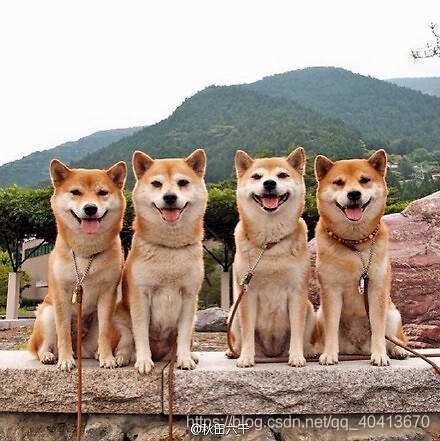
After a short wait, the identification will be completed.
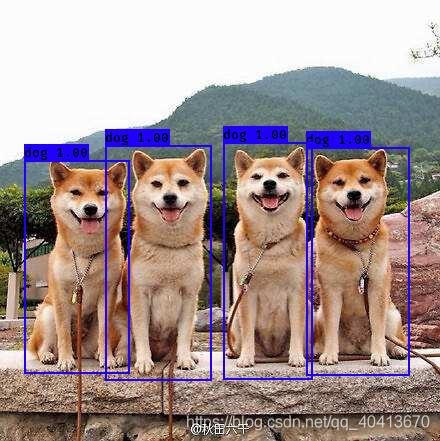
Model Training
Prepare the Dataset
First, you need to prepare the directory structure. You can download the VOC2007 dataset from http://host.robots.ox.ac.uk/pascal/VOC/voc2007/, then delete all the files, leaving only the directory structure. Alternatively, you can manually create the following directory structure:
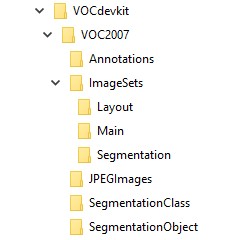
Next, place all the images in the JPEGImages directory. Then, download the labelImg annotation tool from https://github.com/tzutalin/labelImg. This tool is used to annotate the images and create XML files containing the selected image boxes. Open the images using labelImg, annotate them, and save the generated XML files in the Annotations folder with the same names as the images.
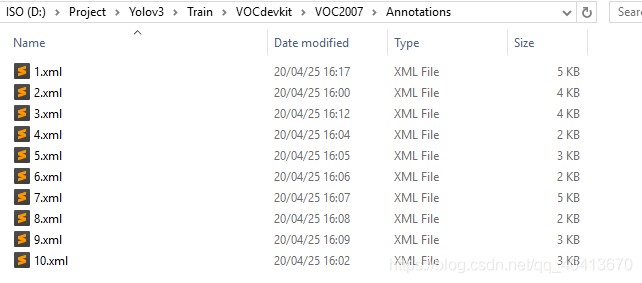
Prepare the Training Files
Create a python file in VOCdevkit/VOC2007, write the following code, and run it. This will generate four txt files in VOCdevkit/VOC2007/ImageSets/Main.

import os
import random
trainval_percent = 0
train_percent = 1 # Divide all into the training set, as YOLO3 will still divide into training and test sets during training, no need to divide here
xmlfilepath = 'Annotations'
txtsavepath = 'ImageSets/Main'
total_xml = os.listdir(xmlfilepath)
num = len(total_xml)
lst = range(num)
tv = int(num * trainval_percent)
tr = int(tv * train_percent)
trainval = random.sample(lst, tv)
train = random.sample(trainval, tr)
ftrainval = open('ImageSets/Main/trainval.txt', 'w')
ftest = open('ImageSets/Main/test.txt', 'w')
ftrain = open('ImageSets/Main/train.txt', 'w')
fval = open('ImageSets/Main/val.txt', 'w')
for i in lst:
name = total_xml[i][:-4] + '\n'
if i in trainval:
ftrainval.write(name)
if i in train:
ftest.write(name)
else:
fval.write(name)
else:
ftrain.write(name)
ftrainval.close()
ftrain.close()
fval.close()
ftest.close()
In the upper directory of VOCdevkit, which is currently in the Train directory, create a python file and run it. This will generate three txt files. Note that in this code, you need to change the classes to the categories you want to train. In my case, I only need to train the person category, so the array only contains the person category.

import xml.etree.ElementTree as ET
from os import getcwd
sets=[('2007', 'train'), ('2007', 'val'), ('2007', 'test')]
classes = ["person"]
def convert_annotation(year, image_id, list_file):
in_file = open('VOCdevkit/VOC%s/Annotations/%s.xml'%(year, image_id),'rb')
tree=ET.parse(in_file)
root = tree.getroot()
for obj in root.iter('object'):
difficult = obj.find('difficult').text
cls = obj.find('name').text
if cls not in classes or int(difficult)==1:
continue
cls_id = classes.index(cls)
xmlbox = obj.find('bndbox')
b = (int(xmlbox.find('xmin').text), int(xmlbox.find('ymin').text), int(xmlbox.find('xmax').text), int(xmlbox.find('ymax').text))
list_file.write(" " + ",".join([str(a) for a in b]) + ',' + str(cls_id))
wd = getcwd()
for year, image_set in sets:
image_ids = open('VOCdevkit/VOC%s/ImageSets/Main/%s.txt'%(year, image_set)).read().strip().split()
list_file = open('%s.txt'%(image_set), 'w')
for image_id in image_ids:
list_file.write('VOCdevkit/VOC%s/JPEGImages/%s.jpg'%(year, image_id))
convert_annotation(year, image_id, list_file)
list_file.write('\n')
list_file.close()
Next, copy all the files in the Train directory to the directory after git clone. At this time, the file directory structure is as follows.

Modify Parameters
At this point, you need to modify the model_data/coco_classes.txt and voc_classes.txt files. Both of these files need to contain the training categories. Similarly, I am only training the person category, so there is only one line person in this place.
Next, modify yolov3.cfg. If you don't need to load pre-trained weights, then it is unnecessary to modify this file. This file is for configuring the generation of yolo_weights.h5. Search for yolo in this file. There will be three matches, all of which require the same way of modification. Taking the first match as an example, there are three places for comments, which means a total of 9 lines need to be changed.
...
[convolutional]
size=1
stride=1
pad=1
filters=18 # 3*(5+len(classes)) # I train one category, thus 3*(5+1) = 18
activation=linear
[yolo]
mask = 6,7,8
anchors = 10,13, 16,30, 33,23, 30,61, 62,45, 59,119, 116,90, 156,198, 373,326
classes=1 # One type of category
num=9
jitter=.3
ignore_thresh = .5
truth_thresh = 1
random=1 # Change to 0 if the memory is small
...
Run python convert.py -w yolov3.cfg yolov3.weights model_data/yolo_weights.h5 to generate model_data/yolo_weights.h5 for loading pretrained weights.
Train Model
Then you can start training. Since I temporarily didn't have data at the beginning, I just tried a few pictures marked arbitrarily. Because there were less than ten pictures and I divided the dataset and training set when building the VOC dataset, and train.py defaults to divide the data into 0.1 as the training set, multiplying 0.1 by less than ten pictures equals 0, which caused errors. It is important to note that you must have a validation set, which means you need at least two pictures, one as the training set and one as the validation set. Otherwise, running train.py will report a KeyError: 'val_loss' error, and running train_bottleneck.py will report a IndexError: list index out of range. In addition, it is also important to manually create the logs/000/ directory to prevent the exception thrown when the model is saved. Generally, training can be done with train.py. For any issues that may occur, you can refer to github's issue and README. For my training purposes, I made some slight modifications to train.py, and there are comments on some of the modifications I made.
"""
Retrain the YOLO model for your own dataset.
"""
import numpy as np
import keras.backend as K
from keras.layers import Input, Lambda
from keras.models import Model
from keras.optimizers import Adam
from keras.callbacks import TensorBoard, ModelCheckpoint, ReduceLROnPlateau, EarlyStopping
from yolo3.model import preprocess_true_boxes, yolo_body, tiny_yolo_body, yolo_loss
from yolo3.utils import get_random_data
def _main():
annotation_path = 'train.txt'
log_dir = 'logs/000/'
classes_path = 'model_data/voc_classes.txt'
anchors_path = 'model_data/yolo_anchors.txt'
class_names = get_classes(classes_path)
num_classes = len(class_names)
anchors = get_anchors(anchors_path)
input_shape = (416,416) # multiple of 32, hw
The judgment of create_tiny_model has been removed here # If load_pretrained is False, the pre-trained weights will not be loaded, and if it is True, the pre-trained weights will be loaded
model = create_model(input_shape, anchors, num_classes,load_pretrained=False,
freeze_body=2, weights_path='model_data/yolo_weights.h5') # make sure you know what you freeze
logging = TensorBoard(log_dir=log_dir)
Change ModelCheckpoint callback to check the model every 10 cycles
checkpoint = ModelCheckpoint(log_dir + 'ep{epoch:03d}-loss{loss:.3f}-val_loss{val_loss:.3f}.h5',
monitor='val_loss', save_weights_only=True, save_best_only=True, period=10)
reduce_lr = ReduceLROnPlateau(monitor='val_loss', factor=0.1, patience=3, verbose=1)
early_stopping = EarlyStopping(monitor='val_loss', min_delta=0, patience=6000, verbose=1)
Divide the input into training and test sets in proportion
val_split = 0.3
with open(annotation_path) as f:
lines = f.readlines()
np.random.seed(10101)
np.random.shuffle(lines)
np.random.seed(None)
num_val = int(len(lines)*val_split)
num_train = len(lines) - num_val
Train with frozen layers first, to get a stable loss.
Adjust the number of epochs to your dataset. This step is enough to obtain a decent model.
if True:
model.compile(optimizer=Adam(lr=1e-3), loss={
# use custom yolo_loss Lambda layer.
'yolo_loss': lambda y_true, y_pred: y_pred})
# The batch_size needs to be changed according to the amount of VRAM
batch_size = 10
print('Train on {} samples, val on {} samples, with batch size {}.'.format(num_train, num_val, batch_size))
epochs is the number of training times
model.fit_generator(data_generator_wrapper(lines[:num_train], batch_size, input_shape, anchors, num_classes),
steps_per_epoch=max(1, num_train//batch_size),
validation_data=data_generator_wrapper(lines[num_train:], batch_size, input_shape, anchors, num_classes),
validation_steps=max(1, num_val//batch_size),
epochs=50,
initial_epoch=0,
callbacks=[logging, checkpoint])
model.save_weights(log_dir + 'trained_weights_stage_1.h5')
Unfreeze and continue training, to fine-tune.
Train longer if the result is not good.
if True:
for i in range(len(model.layers)):
model.layers[i].trainable = True
model.compile(optimizer=Adam(lr=1e-4), loss={'yolo_loss': lambda y_true, y_pred: y_pred}) # recompile to apply the change
print('Unfreeze all of the layers.')
# batch_size needs to be adjusted for the VRAM
batch_size = 10 # note that more GPU memory is required after unfreezing the body
print('Train on {} samples, val on {} samples, with batch size {}.'.format(num_train, num_val, batch_size))
# epochs is the number of training times
model.fit_generator(data_generator_wrapper(lines[:num_train], batch_size, input_shape, anchors, num_classes),
steps_per_epoch=max(1, num_train//batch_size),
validation_data=data_generator_wrapper(lines[num_train:], batch_size, input_shape, anchors, num_classes),
validation_steps=max(1, num_val//batch_size),
epochs=50,
initial_epoch=50)
model.save_weights(log_dir + 'trained_weights_final.h5')
Further training if needed.
```python
def get_classes(classes_path):
'''loads the classes'''
with open(classes_path) as f:
class_names = f.readlines()
class_names = [c.strip() for c in class_names]
return class_names
def get_anchors(anchors_path):
'''loads the anchors from a file'''
with open(anchors_path) as f:
anchors = f.readline()
anchors = [float(x) for x in anchors.split(',')]
return np.array(anchors).reshape(-1, 2)
def create_model(input_shape, anchors, num_classes, load_pretrained=True, freeze_body=2,
weights_path='model_data/yolo_weights.h5'):
'''create the training model'''
K.clear_session() # get a new session
image_input = Input(shape=(None, None, 3))
h, w = input_shape
num_anchors = len(anchors)
y_true = [Input(shape=(h//{0:32, 1:16, 2:8}[l], w//{0:32, 1:16, 2:8}[l], \
num_anchors//3, num_classes+5)) for l in range(3)]
model_body = yolo_body(image_input, num_anchors//3, num_classes)
print('Create YOLOv3 model with {} anchors and {} classes.'.format(num_anchors, num_classes))
if load_pretrained:
model_body.load_weights(weights_path, by_name=True, skip_mismatch=True)
print('Load weights {}.'.format(weights_path))
if freeze_body in [1, 2]:
# Freeze darknet53 body or freeze all but 3 output layers.
num = (185, len(model_body.layers)-3)[freeze_body-1]
for i in range(num): model_body.layers[i].trainable = False
print('Freeze the first {} layers of total {} layers.'.format(num, len(model_body.layers)))
model_loss = Lambda(yolo_loss, output_shape=(1,), name='yolo_loss',
arguments={'anchors': anchors, 'num_classes': num_classes, 'ignore_thresh': 0.5})(
[*model_body.output, *y_true])
model = Model([model_body.input, *y_true], model_loss)
return model
def create_tiny_model(input_shape, anchors, num_classes, load_pretrained=True, freeze_body=2,
weights_path='model_data/tiny_yolo_weights.h5'):
'''create the training model, for Tiny YOLOv3'''
K.clear_session() # get a new session
image_input = Input(shape=(None, None, 3))
h, w = input_shape
num_anchors = len(anchors)
y_true = [Input(shape=(h//{0:32, 1:16}[l], w//{0:32, 1:16}[l], \
num_anchors//2, num_classes+5)) for l in range(2)]
model_body = tiny_yolo_body(image_input, num_anchors//2, num_classes)
print('Create Tiny YOLOv3 model with {} anchors and {} classes.'.format(num_anchors, num_classes))
if load_pretrained:
model_body.load_weights(weights_path, by_name=True, skip_mismatch=True)
print('Load weights {}.'.format(weights_path))
if freeze_body in [1, 2]:
# Freeze the darknet body or freeze all but 2 output layers.
num = (20, len(model_body.layers)-2)[freeze_body-1]
for i in range(num): model_body.layers[i].trainable = False
print('Freeze the first {} layers of total {} layers.'.format(num, len(model_body.layers)))
model_loss = Lambda(yolo_loss, output_shape=(1,), name='yolo_loss',
arguments={'anchors': anchors, 'num_classes': num_classes, 'ignore_thresh': 0.5})(
[*model_body.output, *y_true])
model = Model([model_body.input, *y_true], model_loss)
return model
def data_generator(annotation_lines, batch_size, input_shape, anchors, num_classes):
'''Data generator for fit_generator'''
n = len(annotation_lines)
i = 0
while True:
image_data = []
box_data = []
for b in range(batch_size):
if i==0:
np.random.shuffle(annotation_lines)
image, box = get_random_data(annotation_lines[i], input_shape, random=True)
image_data.append(image)
box_data.append(box)
i = (i+1) % n
image_data = np.array(image_data)
box_data = np.array(box_data)
y_true = preprocess_true_boxes(box_data, input_shape, anchors, num_classes)
yield [image_data, *y_true], np.zeros(batch_size)
def data_generator_wrapper(annotation_lines, batch_size, input_shape, anchors, num_classes):
n = len(annotation_lines)
if n==0 or batch_size<=0: return None
return data_generator(annotation_lines, batch_size, input_shape, anchors, num_classes)
if __name__ == '__main__':
_main()
Model Testing
Once the model training is completed, you can load the model for image testing.
import sys
import argparse
from yolo import YOLO, detect_video
from PIL import Image
if __name__ == '__main__':
config = {
"model_path": "logs/000/trained_weights_final.h5", # Load model
"score": 0.1, # Predictions exceeding this value will be displayed
"iou": 0.5, # Intersection over Union
}
yolo = YOLO(**config)
image = Image.open("./img/1.jpg")
r_image = yolo.detect_image(image)
r_image.save("./img/2.jpg")
Subsequently, you need to continue optimizing parameters and training. In fact, there are many files in the directory that are unnecessary or generally not used after the initial use, so it can be helpful to back up the code and appropriately streamline the directory structure.
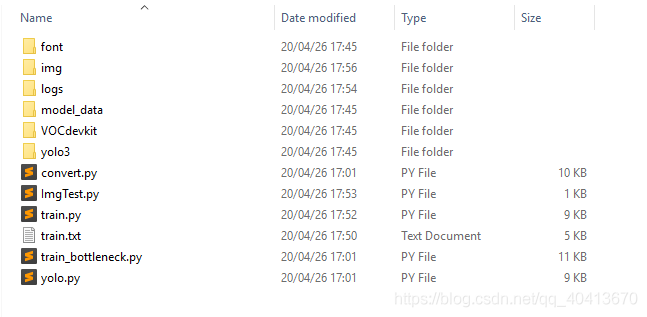
Model Training Example
Downloaded 50 images of traffic lights from Baidu as a training set. This instance is just a demo of model training. The dataset is relatively small, and the relevant information is for reference only.
Runtime Environment
cuda 8.0
python 3.6
keras 2.1.5
tensorflow-gpu 1.4.0
Related Configurations
val_split = 0.1 # Proportion of training set to test set
batch_size = 5 # Number of samples selected for each training
epochs = 300 # Training three hundred times
Running Result
There are more red lights in the dataset, so the confidence of the red lights in the training result is 0.60 and 0.72, and there are fewer samples of green lights, so the confidence of recognizing green lights is 0.38. Overall, the effect is still acceptable.
loss: 25.8876 - val_loss: 38.1282
Original Image
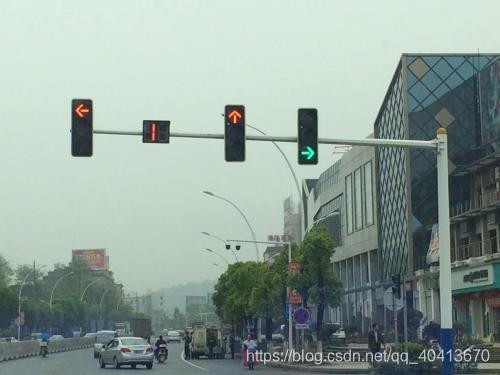
Recognition
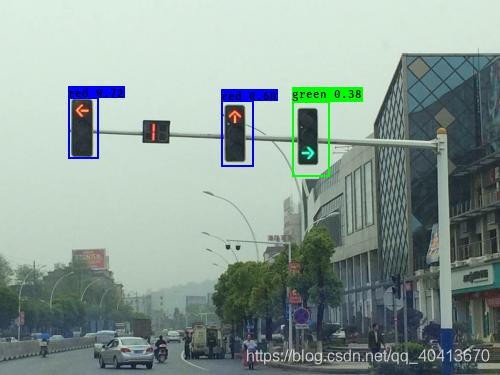
Example Code
If you find it useful, please give us a star 😃
https://github.com/WindrunnerMax/Example










